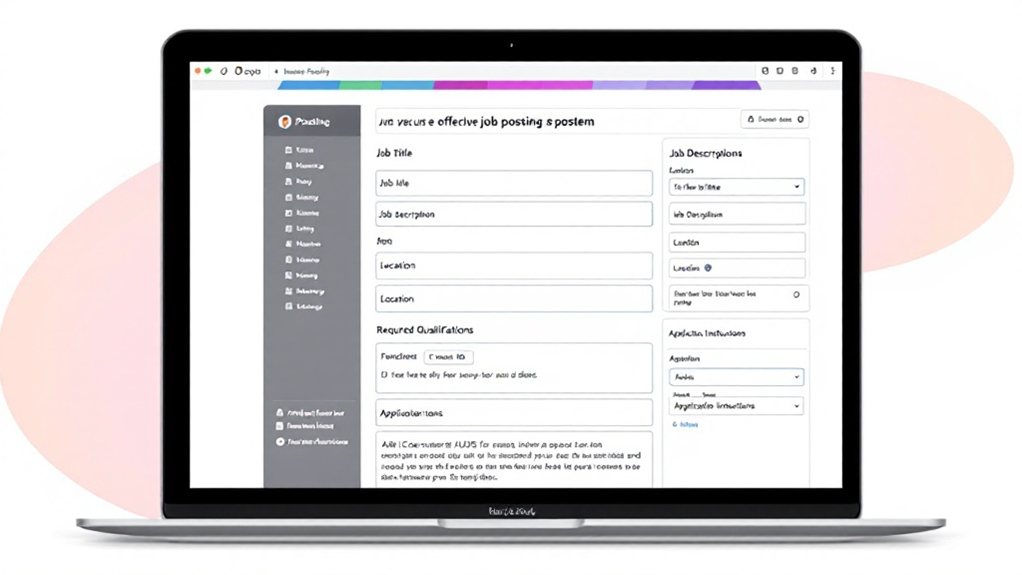Using job posting schema can significantly boost your local business's visibility and attract better-suited candidates. First, generate the necessary schema markup using online tools, inputting key details like job title, description, and company information. Then, customize the schema to highlight flexible work options, accurate salary details, and local business specifics. Validate the schema implementation through Google's Rich Results Test and monitor its performance over time. By leveraging job posting schema, you can gain a competitive edge and optimize your recruitment efforts.
Benefits of Job Posting Schema for Local Businesses

Although local businesses may face various challenges in the digital landscape, leveraging job posting schema can provide a valuable advantage. By improving the visibility of your job listings, this schema enhances the job search experience for candidates. It gives you a competitive edge by highlighting your opportunities more prominently and attracting better-suited applicants. Moreover, the structured data boosts your website's SEO, making it more easily recognized by search engines. Local business schema markup is a type of microdata that can be added to a website's HTML code, which aids in data structuring so search engines can differentiate between different types of content and businesses. From increased click-through rates to voice search readiness, job posting schema offers a well-rounded set of benefits that can streamline your recruitment efforts and strengthen your presence in the job market.
Steps to Implement Job Posting Schema on Website

Generating the necessary job schema markup is crucial for local businesses. Adding schema markup to careers page or job posting page ensures the right candidate finds the business in search results. You'll want to use schema tools to create the JSON-LD code, then validate it through Google's Rich Results Test. Properly configuring and placing the schema code on your job posting pages is the final step to ensure compliance.
Generating Job Schema Markup
To implement Job Posting Schema on your website, you'll need to generate the necessary schema markup. Start by inputting your job details, including the title, description, and company information, into a schema generator tool. These tools will then create the JSON-LD code for your job posting. You can optionally modify the fields to customize the job details further. Most generators support integration with HTML and even React components, requiring minimal coding involvement. Essential schema fields include the job title, description, hiring organization, salary, and posting dates. Be sure to also provide organizational details like the company name, URL, and logo. Leveraging schema management tools and WordPress plugins can streamline the implementation process and ensure your job listings stand out in search results.
Validating Schema Compliance
Validating the compliance of your job posting schema is a crucial step in ensuring its effectiveness. Use Google's Rich Results Test to verify that your schema markup aligns with the latest guidelines. This tool will identify any errors or warnings, allowing you to promptly rectify them. Regularly check for updates to the schema requirements and adjust your implementation accordingly. Maintain consistency between the schema data and the visible job posting information on your website. Accurate and up-to-date schema data will maximize the benefits, improving your visibility in search results and attracting qualified candidates. Continuous monitoring and optimization of your schema implementation are essential for optimizing your recruitment efforts.
Required Fields for Effective Job Posting Schema

When crafting an effective job posting schema, you'll want to ensure you include the essential elements. Start with a straightforward job title, followed by a detailed job description in HTML format. Specify the hiring organization, the physical job location, or indicate a remote position. Don't forget the date the job was posted. Consider including additional recommended attributes like salary, employment type, experience and education requirements, and the industry. Employers with remote jobs are encouraged to use Google for Jobs and emphasize the remote nature of the position. Properly structure the schema using the JobPosting schema from Schema.org, integrating the markup directly into the HTML. Keep job descriptions concise and update listings frequently to ensure compliance with Google's requirements.
Leveraging Job Flexibility Options in Schema Markup
As a local business, you can leverage various job flexibility options in your schema markup to attract top talent. Search engines interpret and prioritize job ads with schema markup more easily, which leads to higher ranking in search results, significantly increasing ad reach and visibility. Whether it's telecommuting opportunities, part-time job flexibility, or shift work options, highlighting these benefits can give you a competitive edge. Ensure your schema accurately represents the flexible work arrangements you offer to provide a seamless user experience for job seekers.
Telecommuting Opportunities
With the growing demand for flexible work arrangements, effectively highlighting telecommuting opportunities in job postings can be a strategic advantage for local businesses. By emphasizing remote work options, you can attract a broader pool of qualified candidates, including those living outside your immediate geographic area. Utilize schema markup to ensure search engines clearly understand job flexibility details, making your postings more visible and appealing to job seekers seeking remote or hybrid roles. Furthermore, provide specifics on the remote work support and collaboration tools you offer, reassuring candidates that your organization is equipped to enable productive and engaged remote teams. Telecommuting can also help local businesses address local talent shortages by expanding their available talent pool.
Part-Time Job Flexibility
Though the rise in part-time job postings offers flexibility for workers, effectively leveraging job flexibility options in schema markup can be crucial for local businesses. By including details about part-time schedules and highlighting the variety of flexible arrangements, you can better attract candidates seeking work-life balance. Sectors with highest shares of part-time roles include service-related jobs. Part-time job schema not only improves visibility but also provides clear information, reducing miscommunication. Additionally, showcasing flexible options can aid in talent acquisition and retention in competitive labor markets. However, balance is key, as excessive part-time staffing may lack stability. Strategically utilizing job posting schema to showcase your flexible offerings can give your local business a competitive edge.
Shift Work Options
Local businesses can leverage the power of shift work options and job flexibility when crafting their online job postings. Offer a variety of shifts, including day, night, and rotating schedules, to cater to different employee needs. Utilize scheduling software to manage complex shift arrangements efficiently. Highlight the benefits of shift work, such as enhanced productivity, work-life balance, and continuous operations. Shift work can be used in any industry, but it may not be economically beneficial in some cases. However, be mindful of the challenges, like sleep disturbances and scheduling complexity. Incorporate employee feedback and remain compliant with labor regulations. By embracing shift work options, you can optimize staffing, improve employee engagement, and adapt to market demands, making your job postings more attractive to potential candidates.
Salary Details and Job Posting Schema
Salary details are a critical component in the job posting schema for local businesses. Including accurate salary information can increase the visibility of your job listings, provide transparency for applicants, and ensure your postings are relevant to their financial expectations. When configuring the job posting schema, be sure to specify the base salary or a salary range using the "minValue" and "maxValue" schema elements. Denote the currency using the ISO code (e.g., USD). Clearly indicate the pay interval, such as yearly, monthly, or hourly. Providing this level of detail can help attract the right candidates for your open positions.
Tools and Generators for Creating Job Posting Schema
To ensure your job posting schema is implemented correctly, you can use tools like the Schema Pro plugin for WordPress or Google's Rich Results Test. The Schema Pro plugin makes it easy to generate and integrate job posting schema directly on your website. The Rich Results Test, on the other hand, allows you to validate your schema markup and identify any issues before publishing.
Schema Pro Plugin
The Schema Pro plugin is a powerful tool that simplifies the process of adding schema markup to your WordPress website. With its intuitive interface, you can easily create and configure job posting schema for your local business.
Key features of Schema Pro include:
- Automation: Streamline the schema addition process for both small and large-scale websites.
- Variable Mapping: Map schema fields to your existing content, saving time and effort.
- Customization: Tailor the schema display and fields based on different job types.
Google's Rich Results Test
While creating compelling job postings is crucial, ensuring they're properly marked up with schema can be just as vital for local businesses. Google's Rich Results Test is a powerful tool to validate your job posting schema. Simply enter your page's URL, and the tool will check for errors, providing detailed feedback to help you fix any issues. This ensures your job listings appear prominently in Google for Jobs, reaching the right candidates. Additionally, Google Search Console provides ongoing schema monitoring, allowing you to quickly address any problems that arise. Combining these tools helps local businesses maximize the visibility and impact of their job postings.
Impact of Local Business Schema on Job Postings
Leveraging local business schema can have a profound impact on the visibility and effectiveness of your job postings. By including specific details about your organization and the job openings, you can improve discoverability and attract more relevant applicants. Here's how local business schema can benefit your job postings:
- Enhanced Search Visibility: Your job listings will be more eligible to appear in specialized Google Search features, boosting their prominence and user engagement.
- Targeted Applicant Attraction: Specifying job details like location and employment type helps you connect with the right candidates.
- Improved Local Search Rankings: Adding schema to your local business job postings can enhance your rankings in local search results.
Validating and Monitoring Job Posting Schema Markup
Validating and monitoring the implementation of job posting schema markup is paramount for local businesses. Utilize Google's Rich Results Test to ensure your schema is properly formatted. Follow the Schema.org guidelines to avoid errors that could hinder search engine recognition. Regularly check for any issues through error identification tools. Remember, accurately specifying location details is crucial for attracting local job seekers.
| Validation Tools | Validation Challenges | Monitoring Performance |
|---|---|---|
| 1. Google's Rich Results Test | 1. Data Accuracy | 1. Google Search Console |
| 2. Schema.org Guidelines | 2. Schema Syntax Errors | 2. Click-Through Rates (CTR) |
| 3. Error Identification | 3. Missing Fields | 3. Application Quality |
Updating and Maintaining Job Posting Schema
Regularly reviewing your job posting schema is crucial to ensure it remains accurate and up-to-date. Utilize tools like Schema Pro to streamline updates in your WordPress settings, and manage your content by checking employment type, salary ranges, and location details. Follow Google's guidelines for structured data to ensure eligibility in job search results, and update your sitemaps to notify Google of changes to job posting URLs.
- Maintain schema validation to avoid errors and ensure proper functioning.
- Set an expiration date or remove listings when the job is filled.
- Analyze how competitors use schema for similar job postings.
Best Practices for Optimizing Job Posting Schema
To optimize your job posting schema effectively, you should focus on incorporating structured data that enhances the search experience for job seekers. By using a structured data format, you can improve visibility and click-through rates, while integrating job locations helps local candidates find relevant opportunities. Ensure your job titles accurately reflect the role and include required schema fields like headline, description, and date posted. Compliance with guidelines is crucial to avoid issues. Structured data provides a richer user experience, enhances visibility, attracts more qualified applicants, and enables better integration with job sites.
| Key Benefits | Improved User Experience | Enhanced Visibility | More Qualified Applicants | Better Integration | Standout Features |
|---|---|---|---|---|---|
| Description | Structured data provides filters for location and job type | Job postings appear more prominently with details like company logos and ratings | Using schema enables job seekers to filter by specific criteria, attracting more suitable candidates | Structured data facilitates integration with Google and third-party job sites | Include essential details such as salary ranges to attract and engage candidates |
